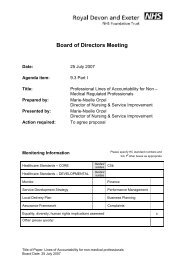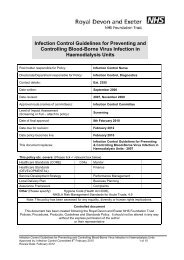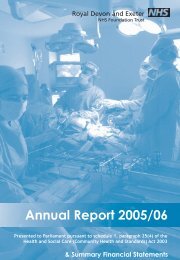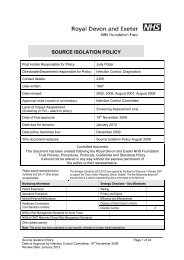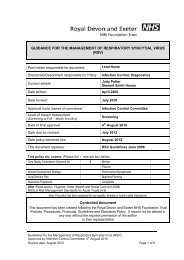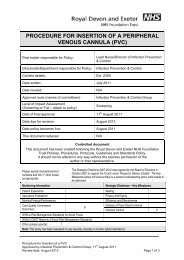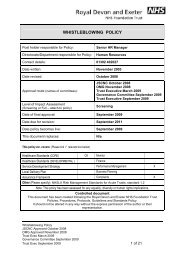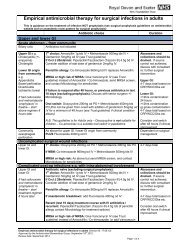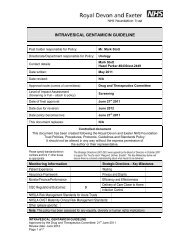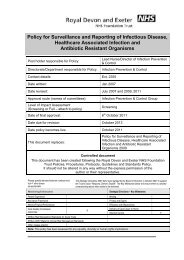Annual Report and Accounts 2012/13 - Royal Devon & Exeter Hospital
Annual Report and Accounts 2012/13 - Royal Devon & Exeter Hospital
Annual Report and Accounts 2012/13 - Royal Devon & Exeter Hospital
Create successful ePaper yourself
Turn your PDF publications into a flip-book with our unique Google optimized e-Paper software.
2. Our Priorities for 20<strong>13</strong>/14<br />
<strong>Royal</strong> <strong>Devon</strong> <strong>and</strong> <strong>Exeter</strong> NHS Foundation Trust<br />
Quality <strong>Report</strong> <strong>2012</strong>/<strong>13</strong><br />
31<br />
The Trust’s priorities<br />
Transforming what we do: our step change<br />
for the future.<br />
Patient safety <strong>and</strong> the quality of care<br />
we offer remains paramount for the<br />
RD&E’s Board. Yet we recognise that<br />
continuing to deliver safe, quality<br />
care within a constrained financial<br />
environment is the single biggest<br />
challenge facing the Trust.<br />
For a number of years now we have<br />
sought to increase the efficiency <strong>and</strong><br />
effectiveness of what we do, whilst<br />
maintaining or even improving quality<br />
<strong>and</strong> safety. Changing what we do<br />
<strong>and</strong> how we do it has enabled us to<br />
meet our savings targets without any<br />
compromise to the quality <strong>and</strong> safety<br />
of the services we offer. Whilst much<br />
remains to be done to streamline<br />
processes <strong>and</strong> eliminate inefficiencies<br />
within the hospital, the Board has<br />
taken the view that incremental<br />
change – whilst important – is unlikely<br />
to deliver the type of transformation<br />
that will be required to sustain the<br />
breadth of services we offer <strong>and</strong> to<br />
deliver them in a sustainable <strong>and</strong> safe<br />
way. That is why we now have a single<br />
transformational change programme,<br />
which is designed to enable us to<br />
deliver clinically safe <strong>and</strong> financially<br />
sustainable care for our patients within<br />
an increasingly challenging economic<br />
environment.<br />
One of the first tasks for the new<br />
programme was to bring together<br />
the large number of improvement<br />
initiatives that have developed<br />
over previous years. Many of these<br />
individual projects were valuable in<br />
creating change. However, we felt<br />
that by assessing their effectiveness<br />
<strong>and</strong> placing them within a coherent<br />
framework with explicit priorities, we<br />
could ensure cross-learning as well as<br />
weed out duplication of effort. Our<br />
renewed transformation programme<br />
now has six key themes:<br />
• Patient journeys through the<br />
hospital <strong>and</strong> beyond<br />
From the moment patients are<br />
referred to the RD&E until their<br />
transfer home or to onward care,<br />
they are on a ‘pathway’ through<br />
our services. We have embarked<br />
on a process to look at these<br />
pathways in detail, with the aim of<br />
making every patient’s pathway as<br />
smooth <strong>and</strong> effective as possible.<br />
The project aims to achieve a<br />
reduction in delays through the<br />
system; a better utilisation of our<br />
bed stock; appropriate reductions<br />
in the length of stay <strong>and</strong> to<br />
ensure that patient outcomes <strong>and</strong><br />
experience are integrated into our<br />
improvement work. As well as<br />
work within our 'four walls' this<br />
project will increasingly involve<br />
integrating our improvements with<br />
external partners in primary <strong>and</strong><br />
social care<br />
• Patient safety<br />
We have a patient safety<br />
programme to provide a clear<br />
focus on safety issues as well<br />
as ensuring that a st<strong>and</strong>ardised<br />
approach to safety can be<br />
implemented. Over the next year<br />
the patient safety programme will<br />
be increasingly integrated within<br />
our work on improving patient<br />
pathways<br />
• Efficient use of resources<br />
We will need to continue to<br />
identify year on year efficiency<br />
savings to meet our financial<br />
targets. The transformation<br />
programme will examine a<br />
wide range of areas – such as<br />
procurement <strong>and</strong> back office<br />
functions – to ensure that our<br />
processes are as efficient as<br />
possible, that we are adopting<br />
the use of technology, <strong>and</strong> that<br />
we identify ways to improve how<br />
some of our functional areas are<br />
organised<br />
• Communications <strong>and</strong><br />
engagement<br />
For our transformation programme<br />
to succeed, we are engaging<br />
with our staff <strong>and</strong> stakeholders.<br />
We want to build a culture of<br />
continuous improvement so that<br />
we are able to sustain our high<br />
quality services. Staff engagement<br />
is central in making these projects<br />
work. It is often those on the<br />
frontline who have the best ideas<br />
about how to change things for<br />
the better. Engagement of our<br />
clinical staff is vital in ensuring that<br />
change adds value for patients <strong>and</strong><br />
the RD&E. All our transformation<br />
projects are overseen by a small<br />
group of clinicians <strong>and</strong> managers



